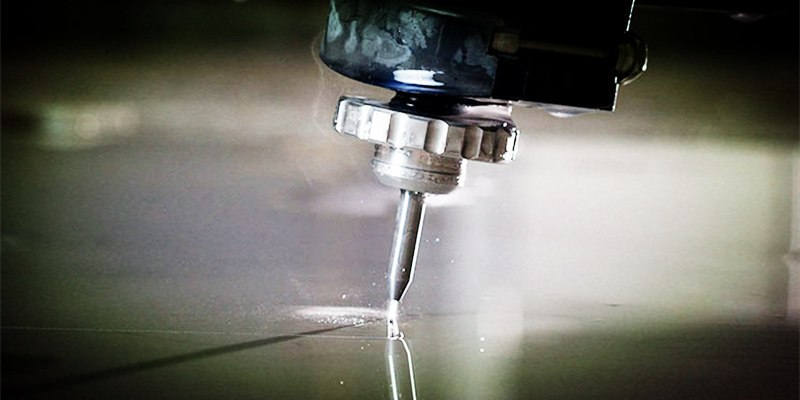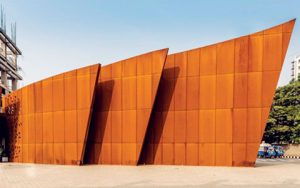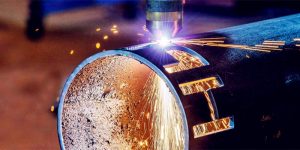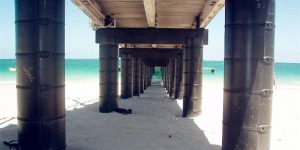Waterjet Cutting Services – Another Good Option to Cut Steel

Waterjet cutting is to use high pressure water to cut or profiling steels and especially for highly brittle materials. It delivers smooth and precise cuts through the mechanical sawing action. This is a versatile process in that it cuts through almost every material.
Octal provides customize waterjet cutting services according client requirements.
Things you should know about waterjet cutting and advantages
Here are a few things about the waterjet process worth noting:
• This process delivers precise cuttings, according to a person’s needs and specifications. In short, it can deliver high tolerance parts because of its narrow kerf width.
• It is slow when compared to other metal fabrication methods.
• It is one of the most expensive techniques in the market. This mostly applies when combined with plasma.
• CNC technology integrated in, fast program, fast layouts, CAD in.
• Cold cutting, no hot transformations
• No pollution, no harmful air and dust generated
• The only way to cut compound materials
• Edge smooth, no second cutting required
• One time process of perforation, cutting and profiling
• Lower cutting cost
• High Auto controlled
• 24 hours continuously working
• No need to change cutting torch
• Less cutting blurs.
• No cutting direction limits. Different profile different degree cutting.
2 cutting types by waterjet
Generally, there are two water cutting process, namely the pure water cutting technique and abrasive waterjet cutting process.
Pure water cutting
The pure water cutting technology is meant for soft materials such as food, rubber, textiles and leather. During this technique, water is pressurized into high levels then forced out through a small sapphire or ruby, releasing an intense cutting steam. The steam jet is believed to move 2.5 times the speed of the sound. This is the reason the pure water cutting technology cuts at a high rate, giving out powerful and precise cuttings.
Abrasive waterjet
On the other hand, the abrasive waterjet cutting technology is meant for hard materials that the pure water technology cannot cut through. As the name suggests, the water nozzle is replaced with an abrasive cutting head. The water steam creates a vacuum thus drawing the abrasive into a chamber facilitating the production of powerful abrasive jet steam.
This is the commonly known waterjet cutting steel process. The abrasive process cuts through nay material such as slab, glass, sheetmetal and aluminum, among others.
How does the waterjet cut intensifier pump works?
As we all know, the waterjet process operates on ultra high pressure to cut through materials. This process starts off with an intensifier pump. This pump creates the ultra high pressure needed to perform various tasks. The intensifier pump is fitted with a large horsepower motor.
Additionally, it uses a hydraulic pressure. This is how the hydraulic pressure is created and powers piston in a cylinder. Here is a list of other requirements used in this process:
A low pressure water inlet
Water off valve
Boost pump
Accumulator
Inlet check valves
Water filler
An intensified piston
Abrasive metering system and a cutting head.
Key point in waterjet cutting systems
The key point to make waterjet cutting is the clean water system is connected to the low pressure inlet. The water is then forced into the inlet filter through the inlet check valves until it reaches the hydraulic pump. This is the stage where water is pressurized. During this stage, the water pressurizes the hydraulic fluid in the hydraulic pump. The pressure then forces water out of the intensifier and finally into the accumulator. The water then flows into the high pressure tubing into the cutting head. The water flow is controlled by the off valve. This valve allows people to achieve their desired cuttings while using the waterjet cutting process. The abrasive is mixed with high water pressure in the mixing chamber.
How does the intensifier work in waterjet cutting services?
People are always asking how the intensifier is able to create the ultra high water pressure. The larger hydraulic cylinder pushes the small piston in a cylinder full of water. This is how the ultra high water pressure is created. High water pressure enhances the cutting process.
How is waterjet cutting head working
Let us shift our gears and look at how the waterjet cutting head works. The high pressure water can be delivered into the cutting head in two ways. It can be through the hose or the high pressure tubing. The water is then applied to an orifice to help resist abrasion of high pressure water. It is mostly made of sapphire and diamond. The orifice is entitled the task of creating the water stream. Not all materials can be cut by the water stream. There are cases where a person will be required to add an abrasive to the water stream to cut through hard materials such as stone, plastic, aluminum and steel, among others.
The abrasive is the one that does the actual cutting. It is made up of crushed garnet. Consequently, there are other materials a person can use for special applications. Lastly, machines can be cut to meet a person’s exact needs.
Materials that could be used for waterjet cut
Waterjet cutting services could be applied for different materials, metals as carbon, alloy, aluminum, stainless steels, also the brass, copper. Other materials like carbon fiber, plastics, glass.
Octal provide waterjet cut services only for steels as below:
Mild/Carbon Steels
ASTM A36
ASTM A516
ASTM A572
ASTM A573
For carbon steel, waterjet cutting could do upto thickness 40 mm.
Stainless Steels
SS304L
SS316L
SS310
Duplex Stainless Steel
Aluminium and alloy steels
1050A
1200
5083
5251
6061
6082
Waterjet cutting tolerances
Waterjet cutting tolerances usually at +/- 0.25mm generally, for the steel thickness under 30 mm.
If you need customize waterjet cutting, just contact us.

























